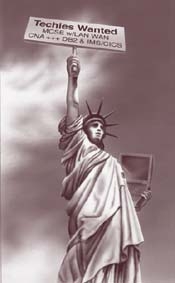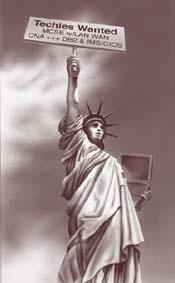
Ironically, today's heightened public pressure to stave off illegal immigration comes at a time when key sectors of the U.S. economy need to rely more heavily than ever on legal, employment-based immigration. The danger is that negative attitudes about one domain unduly shape negative attitudes about another.
To put the point bluntly, American high-tech companies have experienced such rapid growth that they have collectively outpaced the ability of America's educational system to produce a sufficient number of technically knowledgeable workers. The gap between America's besieged educational system and the acute labor needs of high-tech industries creates a situation whereby American companies feel compelled to hire foreign nationals to fill many strategic, technically demanding positions.
There is no better example of success in the high-tech industry than Silicon Valley. Contributing to the global technology incubator of Silicon Valley is a high proportion of foreign nationals working for American companies. In 1996, twenty-three of Forbes magazine's two hundred best small companies were immigrant run. Silicon Valley powerhouses such as Intel, Sun Microsystems, Oracle, Cirrus Logic, Solectron, and Lam Research were all either founded or cofounded by immigrants. In fact, almost all high-tech companies, including Cadence Design Systems, rely on foreign nationals in key positions. At Cadence, roughly 30 percent of its U.S.-based employees are not U.S. citizens.
Legal, employment-based immigration has helped fuel the explosive growth of Silicon Valley companies. The H-1B visa was established to allow foreign nationals to be hired into U.S. companies for a period of three to six years on the basis of their exceptional education, training, or experience. Why does Silicon Valley need such immigrants?
| High-tech companies have grown so fast that they have outpaced the American supply of technically knowledgeable workers. |
High-tech companies need to hire the best and brightest personnel in order to develop and sell the best products. American high-tech companies are competing both against one another and against a growing number of foreign-based companies for revenue and market share. This also means competing for a global pool of human resources and access to critical intellectual capital. The explosive growth of high tech has created a global demand for technically knowledgeable employees that exceeds the current supply, especially for positions requiring specialized education.
This labor shortage is evidenced each week by pages of high-tech job openings listed in the San Jose Mercury News, Silicon Valley's leading newspaper. Cadence, a company of roughly thirty-two hundred employees, typically has more than three hundred job openings to fill at any given time. Still, even with that many positions available, it takes Cadence an average of four to six weeks to fill each opening. The situation is the same at other successful Silicon Valley companies--they can't hire talented employees quickly enough to keep up with their enormous growth potential.
The situation is exacerbated by the weaknesses in the American system of education. The United States lags dangerously behind other countries in contributing to the global pool of knowledge workers. The Third International Mathematics and Science Study, released in November 1996 by the U.S. Department of Education, measures the educational progress of eighth graders in forty-one countries. The United States ranked only twenty-eighth in math and seventeenth in science, whereas Singapore, Japan, and Korea all scored in the top four in both categories.
Many Americans think that the United States makes up for its struggling secondary school system by having the best universities in the world, offering superior programs in math, science, and engineering. America's universities are indeed among the leading institutions worldwide, but foreign students are earning a high proportion of the advanced degrees in fields directly relevant to the fast-growing high-tech industry. According to a 1993 study by the National Science Foundation, among Ph.D. candidates at U.S. universities, 40 percent are foreign born in the engineering and computer science fields and 31 percent are foreign born in mathematical science. By the year 2000, 50 percent of all science and engineering Ph.D. degrees awarded by U.S. universities could go to foreign graduate students by default because not enough American students are enrolled.
| Xenophobia is threatening to erase America's early lead in high tech. |
American students are much more likely to apply engineering and science degrees to employment in business and other nonscience fields than are foreign-born students, who lean toward the practice of math and science disciplines. Even among engineering graduates, Americans are more motivated to take "creative" engineering jobs in specialties such as Internet and multimedia development, whereas foreign nationals are more likely to engage in "hard" engineering disciplines like semiconductor and circuit design. In this setting it is inevitable that labor needs for leading engineers and other knowledge workers are in many cases being filled by qualified and readily available foreign nationals.
The observation is simple enough: The xenophobia underlying much of today's immigration reform movements threatens to erase America's early lead in high tech. If American companies are denied the opportunity to hire as many foreign nationals as they need into key positions, they will undoubtedly shift operations to other countries to meet business demands. An exodus of American high-tech operations to other countries would damage the U.S. economy, sending valuable tax dollars and other expenditures outside the United States. Policymakers must recognize the risk of losing American business to offshore locales if companies cease to enjoy the same growth opportunities historically afforded in the United States.
















